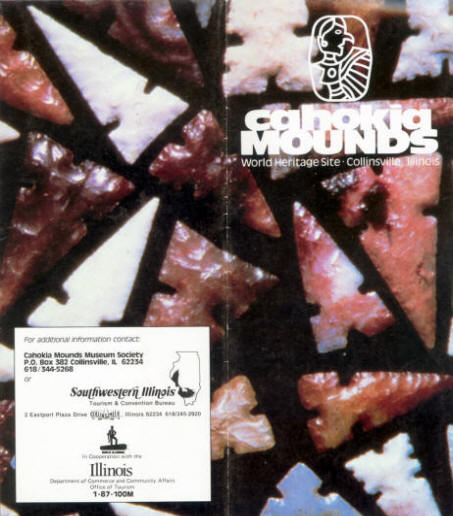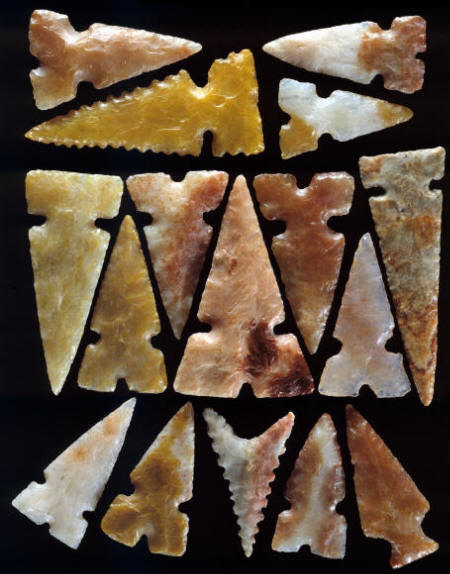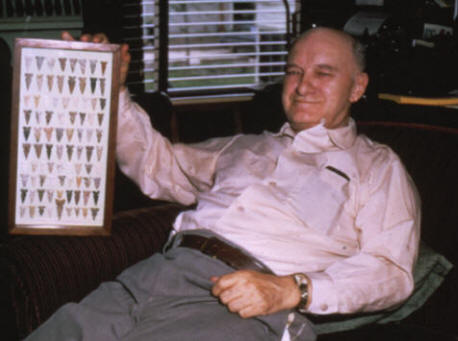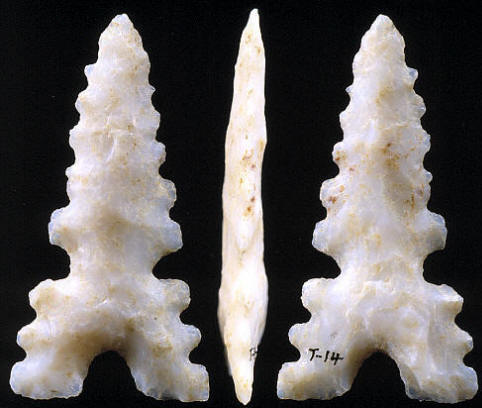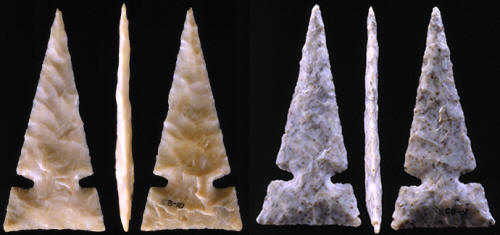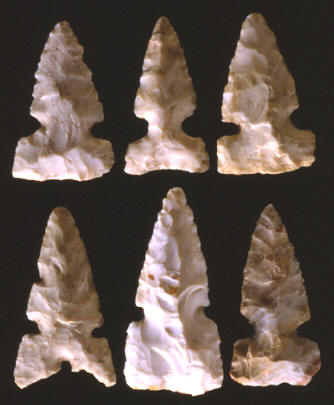|
|
|
Some of the Cahokia "gem points" have taken on names over the years. The locally famous triple-notched Cahokia point known as "Old Red Top" or "Red Tail" was originally in the Kyle Sly collection. Its red base is what made it stand out in a crowd. Some of the other "named" Cahokia points are the "LaDassor Point," the "Perry Parker Point," the "Barber Pole Point," the "Perino Point," the "Rouch Point," and the "Higgens Point". The "LaDassor point" was found by Larry LaDassor and may be the best example of a triple-notched serrated Cahokia point ever found. The "Perry Parker Point" was found by Perry Parker and is considered the best example of a double-notched Cahokia "gem point" ever found. The "Higgins Point" is made of a particularly colorful stripped piece of Kaolin chert. Bill Fecht said Dr. Higgins wore it around his neck for several years on a bola tie. Some of Dr. Higgins points are illustrated in Mooreheadís 1929 book "The Cahokia Mounds." |
|
|
|
|
Ed Rouch is another man who collected several years ago at Cahokia and actually owned and operated one of the farms on the southwest segment of the Cahokia site. His land is now part of the Cahokia Mounds State Historic site. A group of three mounds on his farm are known as the Rouch mound group. He surface collected the cultivated fields on his land and found a large number of various types of Cahokia points and other Mississippian artifacts. In 1998 a member of the family sold his collection. The arrow points numbered approximately 639 points. Most of them are typical Cahokia points, which are thick and not very well flaked. The majority of them are also broken. Ed Rouch had one "gem point" in his collection and Bill Fecht tried to get it from him over the years. He only succeeded in acquiring it when Ed became sick and gave it to Bill Fecht just before he died. |
|
|
|
|
The people who've owned Cahokia "gem points" do seem to have enjoyed them more than other artifacts in their collections. In fact, there is even a history of hiding them from other collectors. For example, William Smail was a collector who had a small group of Cahokia points he had acquired, over a period of several years, from Bill Fecht. Mr. Smail never kept his Cahokia points in his relic room where he displayed all his other artifacts. His collection of Cahokia points were always on his dresser in his bedroom where no one would see them and try to talk him out of them. Another collector who had accumulated a fairly large collection of "gem points" from Bill Fecht was Bob Simons. He also rarely, if ever, showed his Cahokia points to anyone either. But that seems to have been typical. Bill Fecht said once that Gray LaDassor would sometimes put his Cahokia points away before certain collectors would show up at his door because he didnít want to have someone talk him out of any. |
|
|
|
|
A few caches of Cahokia points have been found on the Cahokia Mounds site. The largest of these caches include those found during the excavation of Mound 72 in the early 70ís. Approximately 1,200 points of all types and one-of-a kind stylized forms were found. A construction site produced, a cache of thirty-three Cahokia points that became known as the "Clay Ball Cache." These double and triple notched Cahokia points were made of mostly white Burlington chert. Some of them might be considered "gem points" because they were so thin and finely flaked. The "clay ball cache" was found by Mr. Hampton in the 1950ís or 1960ís when he dug a hole for a septic tank in a subdivision on the Cahokia Mounds site. Those houses have since been torn down and the subdivision land is now part of the State Park. In a shovel full of clay, Mr. Hampton found a cache of 33 Cahokia points. According to Bill Fecht, who purchased the unbroken points, there were only about a dozen or so that were not broken. Bill said the neighborhood kids were playing with them and caused some of the damage. Ed Rough also picked up a couple of dozen crudely made and fire cracked Cahokia points on his farm that were all made of the same material and appear to have been in a cache. |
|
|
|
|
The rarest of all Cahokia points are the bone Cahokia points that may number somewhere between two or four dozen broken and unbroken examples. Most of these are in the Illinois State Museum, Gilcrease Institute in Tulsa and other university & museum collections. There are four or five good examples in private collections. Most of them are serrated with a concave base but some double-notched examples have been recorded that were carved to look like a stone Cahokia point. Itís believed that most of them were effigies of sharkís teeth, which have been found in the Cahokia area. |
|
|
|
|
One thing is for sure. The old days of surface collecting in the shadows of the mounds at Cahokia are only memories now. But the brilliant colors of the Cahokia "gem points" keep the old stories alive. They are a reminder of days gone by when life was slower. When people like Titterington, Higgins, Walta, Sly and Fecht were fascinated by "gem points" they described by using words like pigeon blood, wine red, watermelon, canary yellow and lavender. |
|
|
"REFERENCES"
1929,
Moorehead, Warren K., "General Observations of the Cahokia Group,"
"The Cahokia Mounds," pp. 102-103. |
|
